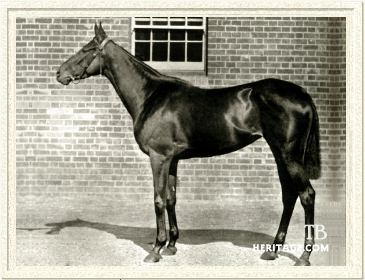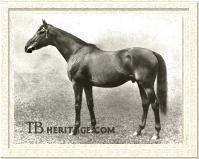|
|
La Fleche

|
|
 |
|
|
La Fleche
was an outstanding race mare, winner of three classic races, who was also a successful broodmare.
She was bred at Hampton Court, one of four significant fillies out of the important
and successful broodmare Quiver. Her full sister Memoir's (1887)
descendents include Miss Gunning II, Foxcraft, Uganda, Umidwar,
Highland Lassie, Palestine, and Wild Again. Half sister Maid Marian
(1886, by Hampton) was the dam of Polymelus, and includes Right Royal V
and Wild Risk among her descendants. The fourth member of this productive
family was Satchel (1882, by Galopin), whose descendants include
the good race filly Haintonette, Belle of All, and Dance in Time.
She was sold as a yearling at auction in the summer of 1890, soon after her elder sister, Memoir, had won the Newmarket Stakes and the Oaks, and there was lively bidding when the handsome filly, by the undefeated St. Simon, came on the block. She was purchased for the then record price for a yearling of 5,500 guineas by Lord Marcus Beresford, bidding for Baron Hirsch, and was sent to John Porter's Kingsclere training stables to join three other brilliant youngsters --Orme, Goldfinch and Windgall.
At age two she ran undefeated in four races: the Chesterfield Stakes at Newmarket, Goodwood's Lavant Stakes and Molecomb Stakes, and Doncaster's Champagne Stakes. At age three she was the winner of eight of her nine races, including three of the classics -- the One Thousand Guineas, the Oaks, and the St. Leger. Her other victories included Goodwood's Nassau Stakes, Manchester's Lancashire Stakes, the Grand Duke Michael Stakes (only two ran), the Newmarket Oaks, and the Cambridgeshire Stakes. Her sole loss was the Derby, where she ran second to the 40 to 1 horse, Sir Hugo by three-quarters of a length; she later easily beat him in a canter in the St. Leger, as well as besting Orme in that race.
At age four she won two of her seven starts, Newmarket's Lowther Stakes and the Liverpool Autumn Cup, in the latter carrying 9 st. 6 lb., but could not prevail in the Manchester November Handicap under 9 st. 11 lb. on a heavy mud turf. At age five, running four times, she won the great distance race, the Ascot Gold Cup, but the next day she failed by half a length to beat the inferior Ravensbury in the Hardwicke Stakes. In October of that year, in foal to Ascot Gold Cup winner Morion and carrying her first foal, La Veine, she won Newmarket's Champion Stakes.
Retired to the stud, she produced the bay La Veine in the spring of 1895, and was bred, unsuccessfully, to Hampton. Baron Hirsch died in 1896, and his horses were sold at auction in June of 1896, including La Fleche, bred to Morion, and her now yearling filly, La Veine. The filly went for a very high price, 3,100 guineas, and La Fleche was knocked down to Beresford for a record 12,600 guineas, who was bidding at the behest of Lady Jessica Cavendish Bentinck Sykes, the wife of Sir Tatton Sykes, whose family had been breeding and racing horses for over one hundred years in Yorkshire. La Fleche was sent to the Sledmere Stud in Yorkshire, where she spent the rest of her days, dying in 1916, having been pensioned after her last cover in 1911.
At Sledmere, in 1897, she foaled her Morion colt, Strong Boy, sold for 2,700 guineas, who eventually won the Ascot Biennial and four other races. Bred to English triple crown winner Isinglass, she produced, in 1898, the bay filly Sagitta, who sold as a yearling for 2,300 guineas, and won the Champion Breeders' Foal Stakes as a juvenile, and later was second and third dam of classic winners in Austria.
Barren to Kendal in 1899, in 1900 she produced another filly, the brown Baroness La Fleche, by the dual-classic winner, Ladas. This filly won the Acorn Stakes, and later became the dam One Thousand Guineas and Coronation Stakes winner Cinna, and a number of other daughters that bred on. Cinna produced the stallion Beau Pere, who was a top sire in New Zealand and Australia before being shipped to the U.S., wher he was also successful. Other Baroness La Fleche daughters included Forest Lassie (1908, by Isinglass), dam of Werwolf (by Hurry On), who became a top jumper sire, and tail female ancestress of Irish Derby winner Rosewell (1935); Baronin (1910, by Isinglass), whose daughter, Lineage, produced Woodcoat Stakes winner Birthright, later a sire, and Victory, dam of the French classic winner Victrix (1934, by Kantar). Another daughter of the Baroness, Sundart (1918, by Sunstar) was tail-female ancestress of good winners in the U.S., France and South America.
La Fleche's next foal, born in 1901, was John o' Gaunt (1901, by Isinglass), an unlucky and not entirely sound youngster who, in the stud, got St. Leger winner Swynford who was later a leading sire of six classic winners and who continued the Isinglass sire line. After John o' Gaunt, La Fleche was twice barren, and then dropped dead twins to Ladas, and was given a year off. Her next foal was the brown Arc de Triomphe, by Gallinule, born in 1906; he was sent to stud in France. Her last foal was a filly by Isinglass, born in 1907, that died in 1908. After that, she failed to catch each year until 1911, when she was retired from production. In all, her youngsters won £5,488, not a great sum, but as seen from the description of her youngsters, she had a major influence on the breed, primarily through Baroness La Fleche and John o' Gaunt.
|

John o' Gaunt
|
|
La Fleche's 1901 colt by Isinglass, John o' Gaunt, was purchased by Sir John Thursby for 3,000 guineas. He placed second in both the Two Thousand Guineas Stakes and Derby Stakes,
despite suffering from ringbone. At stud he got Swynford (1907),
who won the St. Leger, the Eclipse Stakes, the Hardwicke Stakes twice,
and was leading sire in England in 1923 and later a leading sire of broodmares. John O' Gaunt's other offspring included Kennymore, who won the 2,000 Guineas, and Burne Jones, a winner of classic races in Italy. A daughter, Mandy Hamilton, became the dam of the American sire Supremus, after her export to that country.
--Patricia Erigero |
|
|
|

